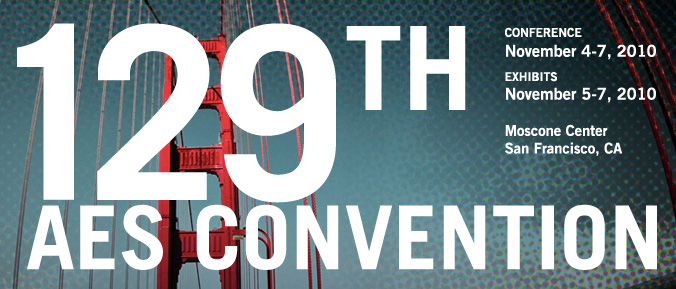
AES San Francisco 2010
Poster Session P20
P20 - Spatial Sound Processing—2
Saturday, November 6, 4:30 pm — 6:00 pm (Room 226)
P20-1 Inherent Doppler Properties of Spatial Audio—Martin Morrell, Joshua D. Reiss, Queen Mary University of London - London, UK
The Doppler shift is a naturally occurring phenomenon that shifts the pitch of sound if the emitting object’s distance to the listener is not a constant. These pitch deviations, alongside amplitude change help humans to localize a source’s position, velocity, and movement direction. In this paper we investigate spatial audio reproduction methods to determine if Doppler shift is present for a moving sound source. We expand spatialization techniques to include time-variance in order to produce the Doppler shift. Recordings of several different loudspeaker layouts demonstrate the presence of Doppler with and without time-variance, comparing this to the pre-calculated theoretical values.
Convention Paper 8278 (Purchase now)
P20-2 A Binaural Model with Head Motion that Resolves Front-Back Confusions for Analysis of Room Impulse Responses—John T. Strong, Jonas Braasch, Ning Xiang, Rensselaer Polytechnic Institute - Troy, NY, USA
Front-back confusions occur in both psychoacoustic localization tests and interaural cross-correlation-based binaural models. Head motion has been hypothesized and tested successfully as a method of resolving such confusions. This ICC-based model set forth here simulates head motion by filtering test signals with a trajectory of HRTFs and shifting an azimuth remapping function to follow the same trajectory. By averaging estimated azimuths over time, the correct source location prevails while the front-back reversed location washes out. This model algorithm is then extended to room impulse response analysis. The processing is performed on simulated binaural impulse responses at the same position but different head angles. The averaging allows the model to discriminate reflections coming from the front from those arriving from the rear.
Convention Paper 8279 (Purchase now)
P20-3 A Set of Microphone Array Beamformers Designed to Implement a Constant-Amplitude Panning Law—Yoomi Hur, Stanford University - Stanford, CA, USA, Yonsei University, Seoul, Korea; Jonathan S. Abel, Stanford University - Stanford, CA, USA; Young-cheol Park, Yonsei University - Wonju, Korea; Dae-Hee Youn, Yonsei University - Seoul, Korea
This paper describes a technique for designing a collection of beamformers, a "beamformerbank," that approximately produces a constant-amplitude panning law. Useful in multichannel recording scenarios, a point source will appear with energy above a specified sidelobe level in at most two adjacent beams, and the beam sum will approximate the source signal. A non-parametric design method is described in which a specified sidelobe level determines beam width as a function of arrival direction and frequency, leading directly to the number and placement of beams at every frequency. Simulation results using several microphone array configurations are reported to verify the performance of proposed technique.
Convention Paper 8280 (Purchase now)
P20-4 A 3-D Sound Creation System Using Horizontally Arranged Loudspeakers—Keita Tanno, Akira Saji, Huakang Li, Jie Huang, The University of Aizu - Fukushima, Japan
In this research we have studied a 3-D sound creation system using 5- and 8-channel loudspeaker arrangements. This system has a great advantage in that it does not require the users to purchase a new audio system or to reallocate loudspeakers. The only change for creators of television stations, video game makers, and so on is to install the new proposed method for creation of the 3-D sound sources. Head-related transfer functions are used to create the signals of left and right loudspeaker groups. An extended amplitude panning method is proposed to decide the amplitude ratios between and within loudspeaker groups. Listening experiments show that the subjects could perceive the elevation of sound images created by the system as well.
Convention Paper 8281 (Purchase now)
P20-5 Locating Sounds Around the Screen—David Black, Hochschule Bremen, University of Applied Sciences - Bremen, Germany; Jörn Loviscach, Hochschule Bielefeld, University of Applied Sciences - Bielefeld, Germany
Today's large-size computer screens can display a wealth of information easily enough to overload the user's visual perceptual channel. Looking for a remedy for this effect, we researched into providing additional acoustic cues through surround sound loudspeakers mounted around the screen. In this paper we demonstrate the results of user evaluations of interaction with screen elements using the surround-screen setup. Results of these tests have shown that applying surround-screen sound can enhance response times in a simple task, and that users can localize the approximate origin of a sound when played back with this technique.
Convention Paper 8282 (Purchase now)
